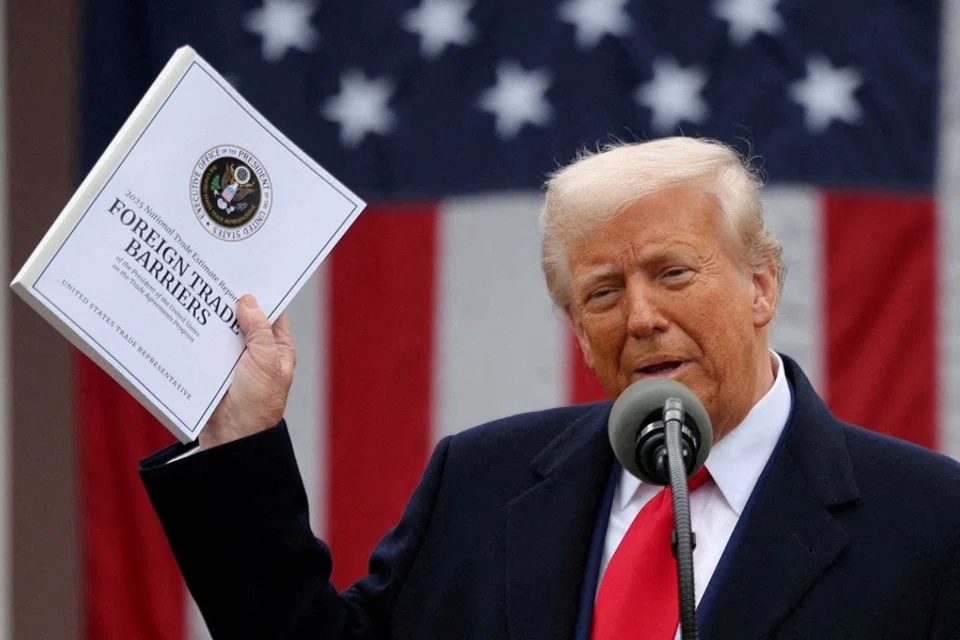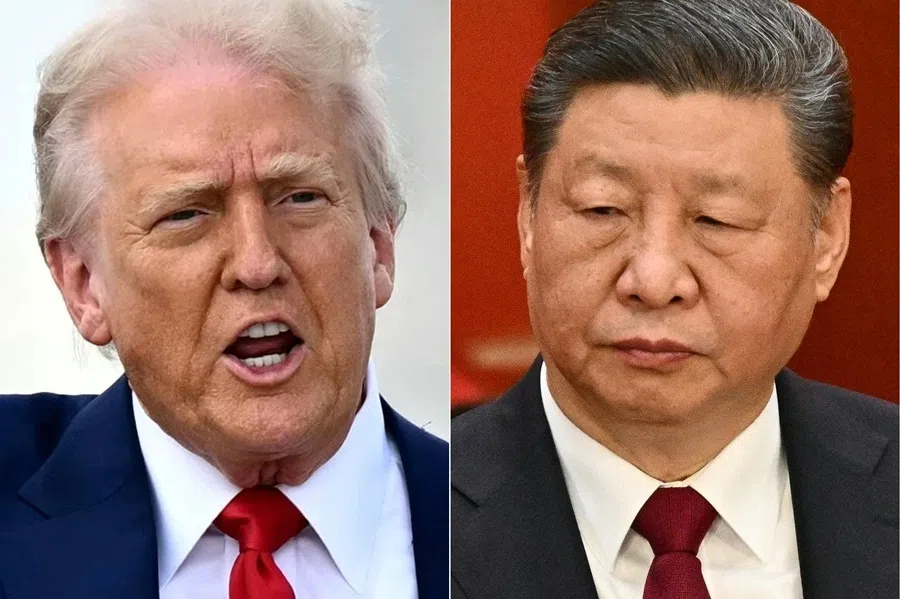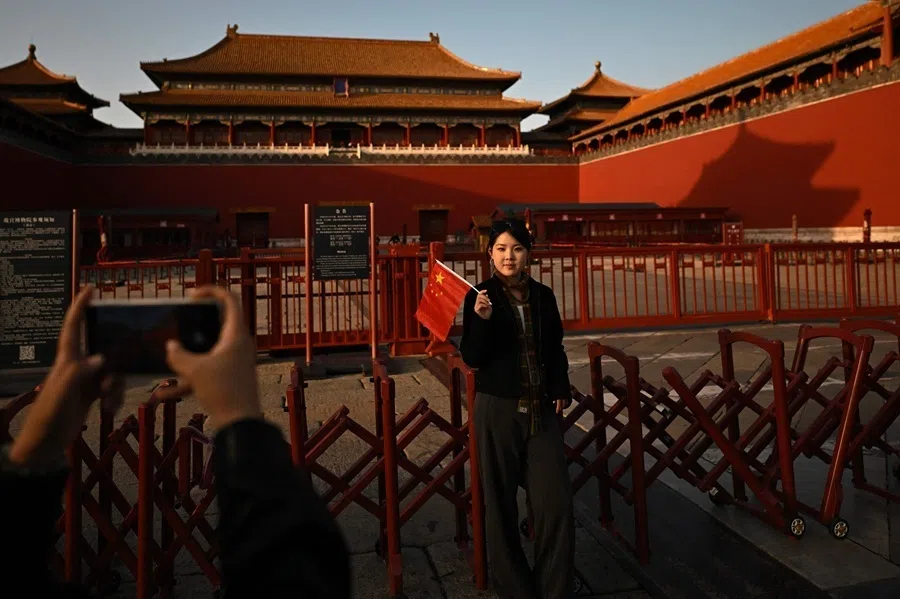Has US-China rivalry become a war of attrition?
The greatest harm brought by US President Donald Trump’s tariffs were not the tariffs themselves, but in the unpredictability of his decision-making process, which has undermined the confidence of stockholders, investment institutions and other countries towards the US, says Lianhe Zaobao associate editor Han Yong Hong.

Less than 14 hours after implementation, US President Donald Trump announced a pause on the hefty tariffs he repeatedly claimed would “liberate” America.
While the stock market was still trading in the afternoon of 9 April, Trump made a surprise announcement on social media: the reciprocal tariffs (up to 50%) imposed on more than 70 countries would be immediately suspended for 90 days, with all tariffs reduced to 10%; however, tariffs on China were increased to 125%, effective immediately, on top of the 20% rate the president had previously imposed on China — bringing the total tariffs to 145%.
Unexpected bond sell-off
Trump explained that the more than 70 countries were given a reprieve because they did not retaliate but instead reached out to negotiate — Trump crudely asserted that everyone is “kissing my ass”. In contrast, China needs to be taught a lesson due to its “lack of respect” for the world market.
However, this is most likely just a self-justification and a face-saving measure for Trump. According to revelations by US media outlets such as CNN and Bloomberg, the real reason Trump made a reversal was a massive bond sell-off. He could not withstand the pressure and had to blink first.
Since Trump proclaimed “Liberation Day” on 2 April, ordinary people have been worried about the sharp decline in the stock market. However, market participants and analysts have been focused on a more critical area — the US Treasury bond market.
A bond sell-off and surge in yields is a nightmare for the US government because it could lead to a skyrocketing interest bill. In 2025, US$9.2 trillion of US debt will either mature or require refinancing, among which US$6.5 trillion will mature in June.

US Treasury bonds have been under immense selling pressure, pushing up yields. The 30-year Treasury bond yield even surged to 5% within the first three days of this week, the largest increase since the Covid-19 pandemic. The trajectory of the benchmark 10-year Treasury bond yield was less dramatic, but still climbed to 4.516% at one point, an increase of more than 50 basis points in two days.
Some analysts have described the US bond market as on the verge of a meltdown, highlighting a collapse in market confidence in the US dollar and Treasury bonds as safe haven assets. If the situation continues to worsen, the US Federal Reserve (Fed) would have to intervene to save the market. The last time the Fed did so was during the initial outbreak of the pandemic in March 2020, when it frantically bought US$1.6 trillion of government bonds within six weeks to stabilise the market.
A bond sell-off and surge in yields is a nightmare for the US government because it could lead to a skyrocketing interest bill. In 2025, US$9.2 trillion of US debt will either mature or require refinancing, among which US$6.5 trillion will mature in June. This is an immediate pressure, and the Trump administration has repeatedly emphasised cost-saving. US Treasury Secretary Scott Bessent described himself as a “bond salesman” in a recent interview. He even asserted that if Treasury yields could be lowered by 100 basis points, the government could save US$100 billion annually.
China or the US — one must go
People therefore speculated that the Trump administration’s unusual calm amid repeated stock market plunges is due to their expectation that the stock market panic will drive more people to buy US Treasuries as a safe haven asset, which will lower bond yields and the US government’s interest expense. But the reverse happened.

Trump’s insane tariff levels and the looming shadow of a US recession triggered a crisis of confidence in US Treasury bonds. This has weakened the traditional safe haven status of US government bonds and could even undermine the dominance of the US dollar. Over the past week, some investors have already started looking for alternatives, such as German and Japanese government bonds.
When discussing the US-China trade war, the Chinese often talk about a Pyrrhic victory. This time, the first round of Trump’s tariff war lasted only seven days, and his losses were not just in terms of the humiliation or the plummeting US stock market — it was also the significant and far-reaching plunge in market confidence in US debt. In fact, the greatest harm brought by Trump’s tariffs were not the tariffs themselves, but in the unpredictability of his decision-making process, which has undermined the confidence of stockholders, investment institutions and other countries towards the US.
... the first scenario is the removal of the US from world trade, and the second is the removal of China from world trade.
It is becoming increasingly clear to the people that the tariff war extends far beyond trade, and would most likely shift into a debt war and currency war. After announcing a temporary suspension of reciprocal tariffs on over 70 countries, Trump abandoned the “one against many” approach to focus his efforts on a direct confrontation with China, in turn making the two scenarios of this conflict more apparent.
Initially, China might have hoped that Trump’s high tariffs would drive more countries away from the US, allowing China to strengthen its economic and even political relations with most countries. It could turn the tariff war into an opportunity by showcasing itself as a defender of free trade and international rules.

However, China now faces sharp challenges beyond the negative economic impact of decoupling from US trade, it also faces the risk of more countries being drawn into the US camp. These countries continue to trade with the US under a 10% baseline tariff, and the US might even force them to choose between China and the US, or use trade barriers to punish and marginalise China. In short, the first scenario is the removal of the US from world trade, and the second is the removal of China from world trade.
... as the rivalry between great powers turns into a war of attrition, the US has more strength while the Chinese are more resilient; it seems neither can win over the other, leading to an extended and intense global turmoil.
Weaker nations at a disadvantage
Clearly, there are trade disputes between China and the US that need to be resolved. If evaluated according to the World Trade Organization rules, China’s trade actions are not without flaws. However, for any country to use its size or hegemony to oppress and exclude weaker nations would be a major violation of international rules.
This principle needs to be clearly understood: in a world where the strongest country bullies the weaker, which in turn bullies an even weaker country, medium-sized countries would bully smaller nations. In such a scenario, only a few countries will benefit at the expense of the interest of a majority of countries. World trade should operate as openly as possible on a foundation of rules.
Trump’s global tariff war has suddenly escalated into a high-stakes confrontation between China and the US, with the next 90 days being crucial for both countries to spare no effort in “corralling friends”. Of course, maybe in the eyes of major nations, there are no friends — only sycophants and those forced into submission. Who is to say?
But as the rivalry between great powers turns into a war of attrition, the US has more strength while the Chinese are more resilient; it seems neither can win over the other, leading to an extended and intense global turmoil. Other countries can only urge them to sit down and negotiate as soon as possible, while digging in their heels to avoid being dragged into the conflict.
This article was first published in Lianhe Zaobao as “特朗普露出了软肋”.





![[Vox pop] Chinese parenting: Tough love or just tough?](https://cassette.sphdigital.com.sg/image/thinkchina/b95bd53631df26290df995775a40e36709bf8dc8e3759460276abd5c426b20b6)